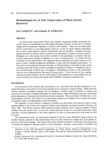Methodologies for in Situ Conservation of Plant Genetic Resources
JIRCAS international symposium series
| ISSN | 13406108 |
|---|---|
| 書誌レコードID(総合目録DB) | AA1100908X |

本文フルテキスト
intlsymp-2_168-173.pdf297.7 KB
In recent times, conservation efforts have typically emphasized habitat protection as a crucial means of maintaining the fast-eroding biological diversity in the face of climatic change and the subsequent migration of plants to new habitats. There are two basic methods for conservation of crop plant genetic resources, in situ, in nature without disturbance, and ex situ, in gene banks at subzero temperatures and low humidity. Presently the latter method has been exclusively used to conserve crop germplasm in genetic resources centers. Biologists are of the opinion that further evolution of the germplasm is arrested when preserved in gene banks and hence relegates it to a sort of museum piece. To counter this line of thought, in situ methods have been suggested where evolutionary processes continue to operate in nature, thereby keeping the germplasm in tune with the changing environment. In this article we describe the biological diversity of wild germplasm to be found in some of the countries within the Fertile Crescent, including archaelogical evidence of widespread cultivation of brittle-rachis Triticum spp., and suggest a mehtodology for their in situ conservation with the use of ethnobotanical information among others. A brief account of four ongoing and future projects aimed at in situ conservation of wild populations of close relatives of our most important food crops in the region under ICARDA's mandate is presented also.
| 作成者 | Jan VALKOUN Ardeshir B. DAMANIA |
|---|---|
| 公開者 | Japan International Research Center for Agricultural Sciences |
| オンライン掲載日 | |
| 号 | 2 |
| 開始ページ | 168 |
| 終了ページ | 173 |
| 言語 | eng |
